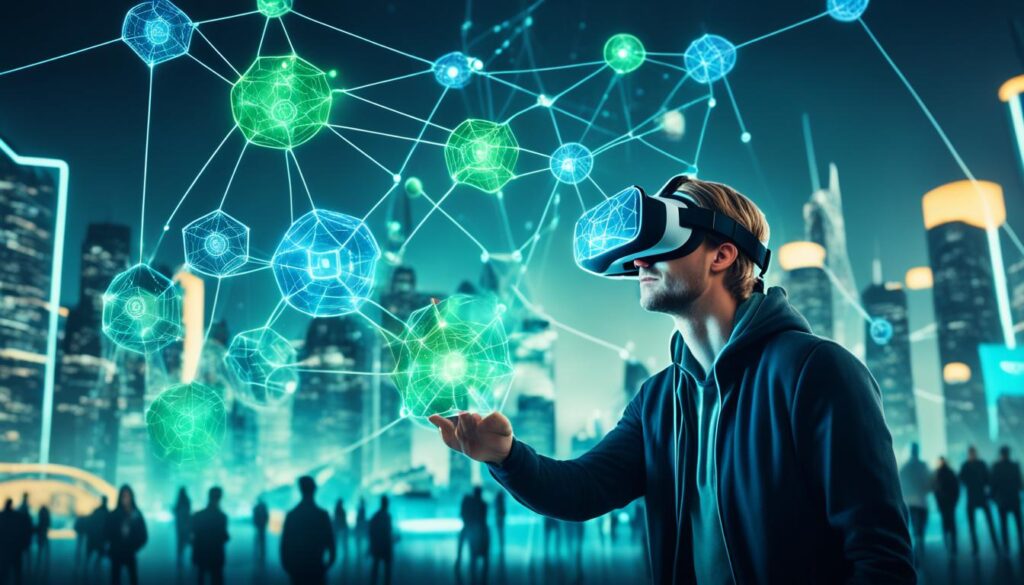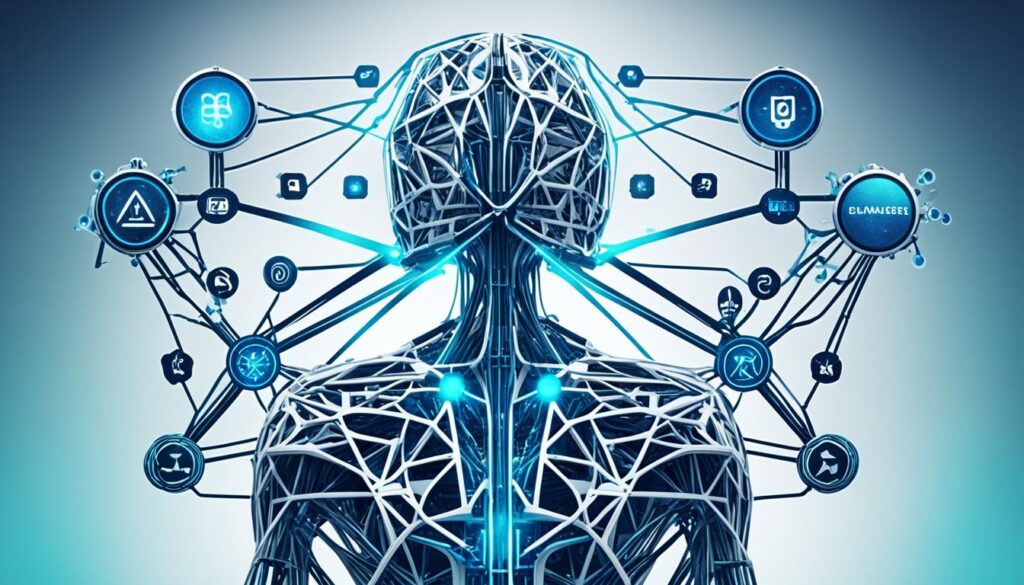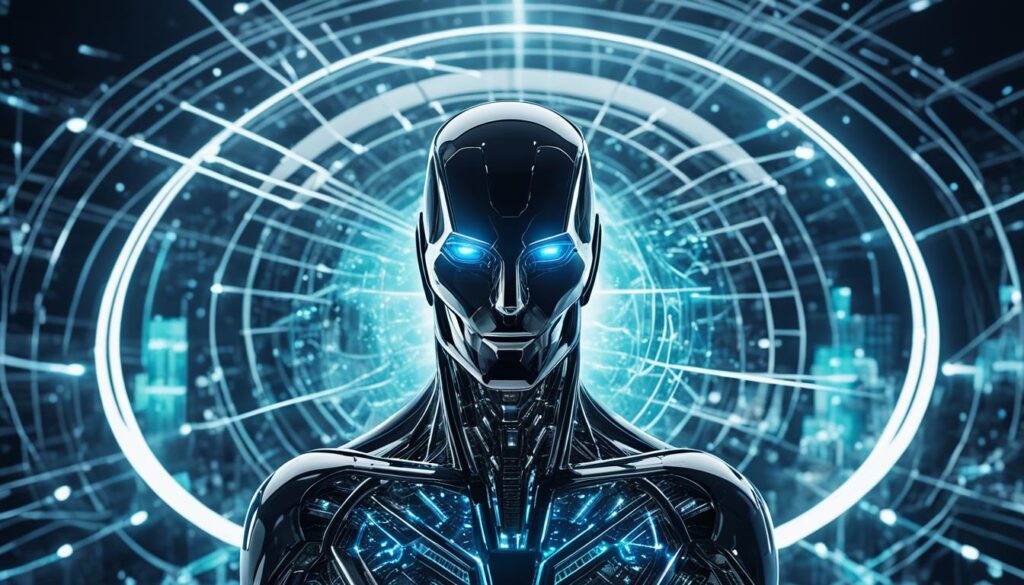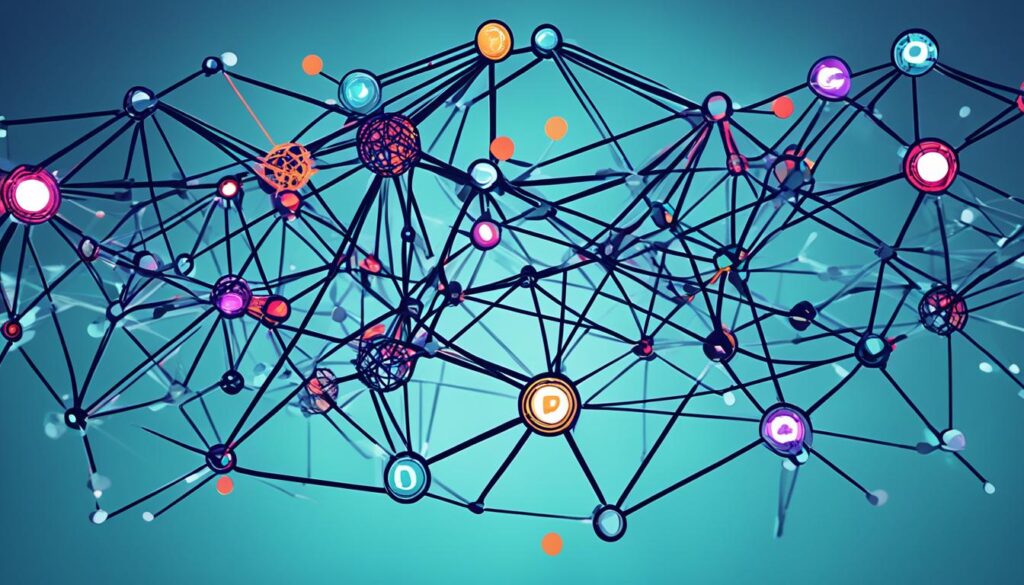As we enter a new era of technology, the potential of decentralized AI and machine learning in Web 3.0 is awe-inspiring. Experts predict that the integration of AI into the decentralized version of the internet will contribute trillions of dollars to the global economy by 2030. Web 3.0 empowers users, creating a more secure and personalized digital ecosystem. However, the convergence of AI and Web 3.0 also presents challenges that must be addressed. This article will explore the immense potential and obstacles in bringing AI and machine learning to the decentralized world of Web 3.0.
Key Takeaways:
- The integration of AI in Web3 has the potential to revolutionize the internet and drive innovation.
- Web3’s decentralized nature coupled with AI’s capabilities empowers users and enhances personalization.
- AI in Web3 can enable smarter dApps, personalized recommendations, and more relevant advertising.
- Improvements in content safety can be achieved through AI’s ability to analyze metadata and identify potential risks.
- The full potential of decentralized AI and machine learning will shape the future of the internet as Web3 continues to evolve.
What is Web3?
Web3 is the next generation of the internet, where decentralization, user control of data, and trustless interactions are key principles. In Web3, power and benefits are distributed among users, ensuring greater privacy, eliminating censorship, and promoting equal distribution of rewards.
At the heart of Web3 is blockchain technology, which allows information to be stored in multiple locations across a network of computers, ensuring transparency and security. This decentralized approach empowers users by giving them full control over their data, eliminating the need for intermediaries and centralized authorities.
Web3 enables the creation of decentralized applications (dApps) that run on blockchains, making it possible to build innovative solutions that are resistant to censorship and manipulation. It fosters a more inclusive and collaborative digital ecosystem where users have the freedom to express themselves, own their data, and participate in the decision-making process.

“Web3 represents a paradigm shift in how we interact with the internet. It puts users back in control of their data, ensuring privacy and security while fostering a more democratic and inclusive digital space.” – Sarah Johnson, Blockchain Expert
Web3’s decentralized internet architecture holds the potential to revolutionize various industries by enabling innovative use cases such as decentralized finance (DeFi), non-fungible tokens (NFTs), and decentralized identity systems.
As Web3 continues to evolve, it is expected that AI and machine learning technologies will play a pivotal role in enhancing the capabilities of decentralized applications, personalizing user experiences, and creating more intelligent digital systems.
What is AI?
Artificial intelligence (AI) is a broad term that refers to computer systems designed to simulate human intelligence and perform tasks without human intervention. AI is revolutionizing various industries and has the potential to shape the future of technology.
There are two types of AI:
1. Strong AI
Strong AI, also known as artificial general intelligence, has the ability to perform tasks that typically require human intelligence. It can reason, learn, and exhibit self-correction capabilities. Strong AI aims to replicate human-like intelligence in machines.
2. Weak AI
Weak AI, also called narrow AI, is designed to perform specific tasks efficiently. It focuses on solving particular problems and lacks the broad cognitive abilities of strong AI. Weak AI is commonly used in various applications and industries, such as virtual assistants, recommendation systems, and image recognition technology.
AI systems learn through different methods, including:
- Reasoning: AI systems use logical reasoning to analyze and process information.
- Learning: AI algorithms learn from vast amounts of data to improve performance and make accurate predictions.
- Self-correction: AI systems can correct their mistakes and improve their performance over time.
AI has a wide range of applications, including:
“AI is transforming industries such as healthcare, finance, transportation, and entertainment. It has the potential to revolutionize the way we live and work.”
Examples of AI technologies include:
- Expert systems: AI systems that replicate human expertise in specific domains.
- Natural language processing (NLP): Technology that allows machines to understand and interpret human language.
- Speech recognition: AI systems that can transcribe and understand spoken language.
- Computer vision: AI algorithms that can analyze and interpret visual data.
AI is continually advancing, and its integration into various industries is reshaping the way we interact with technology. It opens up new possibilities and opportunities for innovation.

Artificial intelligence plays a crucial role in driving technological advancements and improving efficiency in multiple sectors. Its potential is vast, and as AI continues to evolve, it will bring new advancements and opportunities to the forefront.
How AI in Web3 Makes Layers of Web3 Intelligence
AI plays a crucial role in the development and advancement of Web3, contributing to the creation of intelligent blockchains, protocols, and decentralized applications (dApps). The integration of AI in Web3 brings about a new level of intelligence and capabilities, making the entire Web3 stack more efficient and powerful.
Intelligent blockchains are at the core of Web3, incorporating machine learning (ML) capabilities to enhance security, scalability, and consensus protocols. ML-driven blockchains leverage advanced algorithms to optimize performance and address the challenges associated with decentralized networks.
With AI-driven intelligent protocols, Web3 introduces a range of automated decision-making processes. For example, in decentralized finance (DeFi) applications, ML models are used to power computerized market makers and lending protocols, enabling intelligent and autonomous financial transactions.
“Intelligent protocols harness the power of AI to enhance decision-making in decentralized applications, opening up new possibilities for smart and efficient transactions.”
Moreover, dApps are becoming increasingly intelligent in Web3, thanks to the integration of AI technologies. For instance, next-generation non-fungible tokens (NFTs) can exhibit adaptive behavior based on user profiles, creating personalized and interactive digital assets.
A holistic view of AI in Web3 reveals the layers of Web3 intelligence, where ML capabilities drive the development of intelligent blockchains, protocols, and dApps, offering enhanced functionality, security, and user experiences.
Web3 Intelligence Layers
| Layer | Functionality |
|---|---|
| Intelligent Blockchains | Enhanced security, scalability, and consensus protocols through ML-driven capabilities |
| Intelligent Protocols | Automated decision-making in areas like DeFi, leveraging ML models for efficient transactions |
| Intelligent dApps | Next-gen NFTs and adaptive digital assets offering personalized and interactive experiences |
Why AI in Web3?
The integration of AI in Web3 brings several benefits. It shifts the focus from centralized AI models that extract value from users to AI models that serve all people. Users have full control over their data, AI models, and digital assets, empowering them and ensuring fairer compensation for content creators. AI in Web3 also moves from token scarcity to utility, creating new value from user-generated content and enabling collaborations. Additionally, AI allows users to transition from passive consumption to active participation in value creation.
“The integration of AI in Web3 marks a significant shift in how we perceive and interact with technology. By empowering users and prioritizing their control over data, AI in Web3 fosters a more inclusive and equitable digital ecosystem. Gone are the days of centralized AI models that exploit user data for profit. With the decentralized nature of Web3, individuals have the power to determine the use and ownership of their data, leading to improved privacy and fairer compensation for content creators. This fundamental shift in the AI paradigm brings us one step closer to a future where technology serves the collective rather than a select few.”
One of the key advantages of decentralized AI applications in Web3 is the empowerment it provides to users. With user ownership of data at the forefront, individuals have the authority to decide how their personal information is utilized. This shift in power dynamics not only protects user privacy but also ensures that users are compensated fairly for their contributions to the digital ecosystem. Whether it’s sharing data, contributing to AI models, or creating user-generated content, individuals play an active role in shaping the AI landscape.
The transition from token scarcity to utility is another exciting aspect of AI in Web3. Unlike traditional models that rely on limited token availability, AI in Web3 focuses on the practical uses and value generated by decentralized applications. This shift opens up a world of possibilities for collaboration and innovation, as users can leverage their skills, data, and AI models to create new forms of value. It’s a transformative shift that promotes active participation and encourages users to become creators and contributors rather than passive consumers.
Overall, the integration of AI in Web3 represents a paradigm shift in how we interact with technology. By decentralizing AI applications, empowering users, and promoting data ownership, Web3 opens up new avenues for user-driven innovation and value creation. As the Web3 ecosystem continues to evolve, the potential for decentralized AI to shape the future of technology and empower individuals is boundless.

Key Web3 Areas Where AI Shows Promise
AI (Artificial Intelligence) is revolutionizing various aspects of Web3, offering exciting opportunities for personalized experiences, smarter decentralized applications (dApps), relevant advertising, and enhanced content safety. Let’s explore how AI is transforming these key areas within the Web3 ecosystem:
Personalized Recommendations
AI-powered algorithms analyze user preferences, behavior, and historical data to provide personalized recommendations tailored to each individual’s unique interests. By understanding users’ needs and preferences, Web3 platforms can curate content, products, and services that align with their specific tastes and preferences.
Smarter dApps
Integrating AI into dApps empowers them to become smarter and more useful, offering enhanced functionality and real-world utility to users. AI algorithms can enable dApps to adapt to user behavior, making them more intuitive and capable of delivering personalized experiences that meet users’ evolving needs.
Relevant Advertising
AI in Web3 enables more relevant and targeted advertising by leveraging user data and behavior patterns. With AI-powered advertising algorithms, businesses can deliver advertisements that are tailored to individual users, maximizing the chances of engagement and conversion. This not only benefits businesses but also ensures that users receive advertisements that are more relevant to their interests and needs.
Content Safety
Ensuring content safety is a crucial aspect of Web3. AI plays a vital role in analyzing metadata, identifying potential risks, and detecting harmful behavior, promoting a safer digital environment. By leveraging AI-driven content safety measures, Web3 platforms can protect users from malicious content, spam, and other potential threats.

AI’s impact in these areas of Web3 showcases the potential for transformative growth, empowering users, and enhancing their overall digital experiences. With personalized recommendations, smarter dApps, relevant advertising, and content safety, AI in Web3 is revolutionizing the way we interact with decentralized systems.
AI-Driven Predictive Analytics in Web3
AI-powered predictive analytics plays a crucial role in Web3, unlocking a realm of possibilities for businesses. By analyzing large volumes of decentralized data, AI algorithms can extract valuable insights that drive informed decision-making, optimize smart contracts and workflows, and provide businesses with a competitive edge.
One of the key technologies that enable AI-driven predictive analytics in Web3 is natural language processing (NLP). With NLP, real-time language translation, sentiment analysis, and content moderation become possible, opening up avenues for global communication and enhanced user experiences.
“With AI-driven predictive analytics, businesses can gain valuable insights from the vast amount of decentralized data in Web3. This empowers them to make data-driven decisions, optimize operations, and drive innovation.”
Through smart contract optimization, AI algorithms can identify patterns, detect anomalies, and suggest improvements, enabling businesses to streamline their processes and improve efficiency. By leveraging AI’s predictive capabilities, businesses can not only identify potential risks but also seize opportunities that could otherwise go unnoticed.
| Use Case | Description |
|---|---|
| Smart Contract Optimization | AI analyzes smart contract data to identify inefficiencies, suggest optimizations, and improve overall contract performance. |
| Natural Language Processing (NLP) | NLP enables real-time language translation, sentiment analysis, and content moderation in Web3 applications, enhancing user experiences and facilitating global communication. |
| Business Insights | AI-powered predictive analytics provides businesses with actionable insights from decentralized data, enabling informed decision-making and driving innovation. |
AIOptic, a leading AI analytics platform, leverages advanced machine learning algorithms to provide businesses with valuable business insights. By harnessing the power of AI and predictive analytics, organizations can uncover hidden patterns, identify customer preferences, and gain a competitive advantage in the Web3 ecosystem.
A combination of AI-driven predictive analytics, smart contract optimization, and NLP technologies empowers businesses to extract valuable insights from the decentralized web and achieve new heights in operational efficiency and innovation.
Conclusion
The integration of decentralized AI and machine learning in Web 3.0 has the potential to revolutionize the internet and drive innovation. With Web3’s decentralized nature and AI’s capabilities, users are empowered, personalization is enhanced, and user-driven content creation is fostered.
By incorporating AI into Web3, we can experience smarter decentralized applications (dApps) that offer personalized recommendations, relevant advertising, and improved content safety. This integration enables us to create a digital ecosystem where users have control over their data and are fairly compensated for their contributions.
As Web3 continues to evolve, the full potential of decentralized AI and machine learning will be realized, shaping the future of the internet. The convergence of Web 3.0 and AI opens up countless opportunities for innovation, collaboration, and value creation. It is an exciting time as we harness the power of AI in the decentralized realm to create a more user-centric and secure digital landscape.
FAQ
What is Web3?
Web3 refers to the next generation of the internet, characterized by decentralization, user control of data, and trustless interactions. It aims to create a digital ecosystem where power and benefits are shared among users, ensuring greater privacy, no censorship, and equal distribution of rewards. Web3 relies on blockchain technology and enables the creation of decentralized applications (dApps) running on blockchains.
What is AI?
AI, or artificial intelligence, refers to computer systems that simulate human intelligence and perform tasks without human intervention. There are two types of AI: strong AI, which can perform human-like tasks, and weak AI, which is designed for specific jobs. AI systems learn through reasoning, learning, and self-correction. Examples of AI include expert systems, natural language processing (NLP), speech recognition, and computer vision.
How does AI in Web3 make layers of Web3 intelligence?
AI is integrated into different layers of the Web3 stack. Intelligent blockchains include machine learning-driven capabilities, such as scalable consensus protocols and enhanced security. Intelligent protocols, like DeFi computerized market makers and lending protocols, utilize machine learning models for intelligent decision-making. Decentralized applications (dApps) are also becoming more intelligent, with next-generation NFTs capable of adaptive behavior based on user profiles.
Why is AI important in Web3?
AI in Web3 brings several benefits. It shifts the focus from centralized AI models that extract value from users to AI models that serve all people. Users have full control over their data, AI models, and digital assets, empowering them and ensuring fairer compensation for content creators. AI in Web3 also moves from token scarcity to utility, creating new value from user-generated content and enabling collaborations. Additionally, AI allows users to transition from passive consumption to active participation in value creation.
In which key areas does AI show promise in Web3?
AI in Web3 shows promise in several key areas. It can enhance the user experience by providing personalized recommendations based on individual preferences. AI-powered dApps can become smarter and more useful, offering improved real-world utility to users. AI algorithms enable more relevant and targeted advertising. Additionally, AI enhances content safety by analyzing metadata and identifying potential risks or harmful behavior.
How does AI-driven predictive analytics in Web3 benefit businesses?
AI-driven predictive analytics play a crucial role in Web3. By analyzing large amounts of decentralized data, AI can provide businesses with actionable insights, optimize smart contracts and workflows, and enable more effective decision-making. Natural language processing (NLP) technology enables real-time language translation, sentiment analysis, and content moderation in Web3 applications. AI-driven predictive analytics offer tremendous potential for improving business operations and driving innovation.
What is the potential of decentralized AI and machine learning in Web3?
The integration of decentralized AI and machine learning in Web3 holds immense potential for transforming the internet and driving innovation. Web3’s decentralized nature, coupled with AI’s capabilities, empowers users, enhances personalization, and fosters user-driven content creation. Smarter dApps, personalized recommendations, relevant advertising, and improved content safety are just a few examples of the benefits of AI in Web3. As Web3 continues to evolve, the full potential of decentralized AI and machine learning will be realized, shaping the future of the internet.








